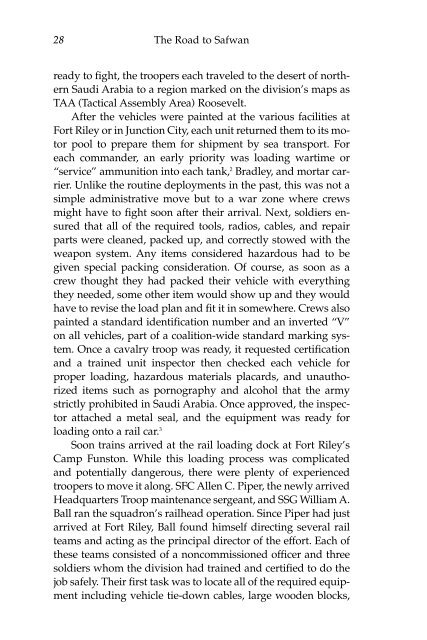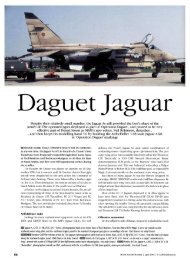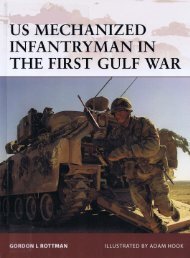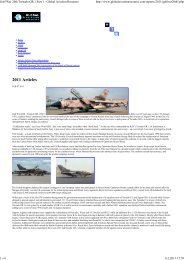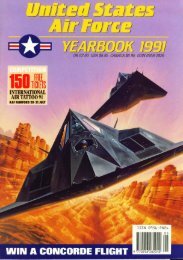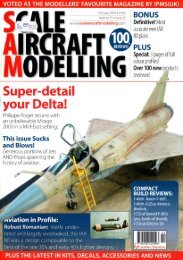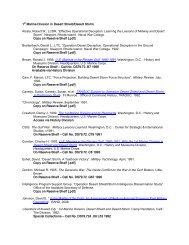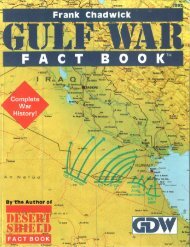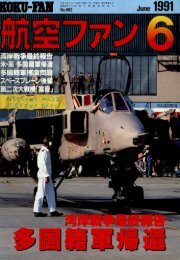The Road to Safwan: The 1st Squadron, 4th Cavalry in the 1991 ...
The Road to Safwan: The 1st Squadron, 4th Cavalry in the 1991 ...
The Road to Safwan: The 1st Squadron, 4th Cavalry in the 1991 ...
You also want an ePaper? Increase the reach of your titles
YUMPU automatically turns print PDFs into web optimized ePapers that Google loves.
28 <strong>The</strong> <strong>Road</strong> <strong>to</strong> <strong>Safwan</strong><br />
ready <strong>to</strong> fight, <strong>the</strong> troopers each traveled <strong>to</strong> <strong>the</strong> desert of nor<strong>the</strong>rn<br />
Saudi Arabia <strong>to</strong> a region marked on <strong>the</strong> division’s maps as<br />
TAA (Tactical Assembly Area) Roosevelt.<br />
After <strong>the</strong> vehicles were pa<strong>in</strong>ted at <strong>the</strong> various facilities at<br />
Fort Riley or <strong>in</strong> Junction City, each unit returned <strong>the</strong>m <strong>to</strong> its mo<strong>to</strong>r<br />
pool <strong>to</strong> prepare <strong>the</strong>m for shipment by sea transport. For<br />
each commander, an early priority was load<strong>in</strong>g wartime or<br />
“service” ammunition <strong>in</strong><strong>to</strong> each tank, 2 Bradley, and mortar carrier.<br />
Unlike <strong>the</strong> rout<strong>in</strong>e deployments <strong>in</strong> <strong>the</strong> past, this was not a<br />
simple adm<strong>in</strong>istrative move but <strong>to</strong> a war zone where crews<br />
might have <strong>to</strong> fight soon after <strong>the</strong>ir arrival. Next, soldiers ensured<br />
that all of <strong>the</strong> required <strong>to</strong>ols, radios, cables, and repair<br />
parts were cleaned, packed up, and correctly s<strong>to</strong>wed with <strong>the</strong><br />
weapon system. Any items considered hazardous had <strong>to</strong> be<br />
given special pack<strong>in</strong>g consideration. Of course, as soon as a<br />
crew thought <strong>the</strong>y had packed <strong>the</strong>ir vehicle with everyth<strong>in</strong>g<br />
<strong>the</strong>y needed, some o<strong>the</strong>r item would show up and <strong>the</strong>y would<br />
have <strong>to</strong> revise <strong>the</strong> load plan and fit it <strong>in</strong> somewhere. Crews also<br />
pa<strong>in</strong>ted a standard identification number and an <strong>in</strong>verted “V”<br />
on all vehicles, part of a coalition-wide standard mark<strong>in</strong>g system.<br />
Once a cavalry troop was ready, it requested certification<br />
and a tra<strong>in</strong>ed unit <strong>in</strong>spec<strong>to</strong>r <strong>the</strong>n checked each vehicle for<br />
proper load<strong>in</strong>g, hazardous materials placards, and unauthorized<br />
items such as pornography and alcohol that <strong>the</strong> army<br />
strictly prohibited <strong>in</strong> Saudi Arabia. Once approved, <strong>the</strong> <strong>in</strong>spec<strong>to</strong>r<br />
attached a metal seal, and <strong>the</strong> equipment was ready for<br />
load<strong>in</strong>g on<strong>to</strong> a rail car. 3<br />
Soon tra<strong>in</strong>s arrived at <strong>the</strong> rail load<strong>in</strong>g dock at Fort Riley’s<br />
Camp Funs<strong>to</strong>n. While this load<strong>in</strong>g process was complicated<br />
and potentially dangerous, <strong>the</strong>re were plenty of experienced<br />
troopers <strong>to</strong> move it along. SFC Allen C. Piper, <strong>the</strong> newly arrived<br />
Headquarters Troop ma<strong>in</strong>tenance sergeant, and SSG William A.<br />
Ball ran <strong>the</strong> squadron’s railhead operation. S<strong>in</strong>ce Piper had just<br />
arrived at Fort Riley, Ball found himself direct<strong>in</strong>g several rail<br />
teams and act<strong>in</strong>g as <strong>the</strong> pr<strong>in</strong>cipal direc<strong>to</strong>r of <strong>the</strong> effort. Each of<br />
<strong>the</strong>se teams consisted of a noncommissioned officer and three<br />
soldiers whom <strong>the</strong> division had tra<strong>in</strong>ed and certified <strong>to</strong> do <strong>the</strong><br />
job safely. <strong>The</strong>ir first task was <strong>to</strong> locate all of <strong>the</strong> required equipment<br />
<strong>in</strong>clud<strong>in</strong>g vehicle tie-down cables, large wooden blocks,


